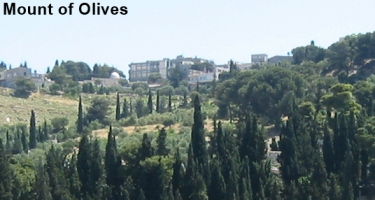The second Old Testament reference to the Mount relates to Christ's Second Coming to the earth. The book of Zechariah states the following.
And the Lord shall go out and fight against those nations, as when He fought in the day of battle. And His feet shall stand in that day upon the Mount of Olives, which is before Jerusalem on the east, and the Mount of Olives shall split in two . . . (Zechariah 14:3 - 4, HBFV).
Not surprisingly, the Mount received its name from the many trees along its sides that bore olives. The hill itself is located on a ridge on the eastern side of Jerusalem and is separated from the city by the valley of Kidron. It is approximately a Sabbath-day's journey from Jerusalem (or less than half a mile or 2,000 cubits). This location plays a pivtoal role in the New Testament and in particular the ministry of Jesus.
Prophetic importance
It was while leaving Jerusalem's temple for the Mount of Olives that Jesus predicted its total destruction when he stated "Do you not see all these things (the beauty of the temple)? Truly I say to you, there shall not be left here even a stone upon a stone . . ." (Matthew 24:1 - 2, HBFV, see also Mark 13:1 - 2 and Luke 21:5 - 6).

It was on the mount that Jesus, just a few days before his crucifixion, wept over the city (Luke 19:37 - 44). It was also here that he gave prophesies about the events to occur just before his second coming to earth and the completion of the age (Matthew 24:3 - 26:2, Mark 13:3 - 7 and Luke 21:7 - 38).
Jesus led his disciples to Olivet (at the foot of which lies the garden of Gethsemane) after his last Passover so that he could teach them a few more things, pray, then wait for Judas to betray him (Matthew 26:30 - 56). While walking to Mount Olivet he gave the parable of the True Vine (John 15:1 - 27), offered his disciples final words of encouragement (John 16:1 - 31) and stated they would all abandon him (John 16:32 - 33).
Commission with promise
It was on Olivet, just forty days after his resurrection (on May 18th, 30 A.D.), that Jesus met with the disciples one last time. He commissions them to preach the gospel everywhere and tells them to wait in the city of Jerusalem until they receive power "from on high" (Luke 24:46 - 49). He then ascends into heaven!
As the disciples gaze at Jesus ascending out of their sight, two angels in white appear. The angels tell them that Christ will come back to the earth in the same way they saw him leave (Mark 16:19 - 20, Luke 24:50 - 53, Acts 1:6 - 11).
Jesus' prophetic return to the Mount of Olives will cause it to split in two, forming two smaller hills (one moving east and the other moving west) that will produce a wide valley. He will then set up his headquarters in Jerusalem and rule the earth with peace and prosperity for 1,000 years!